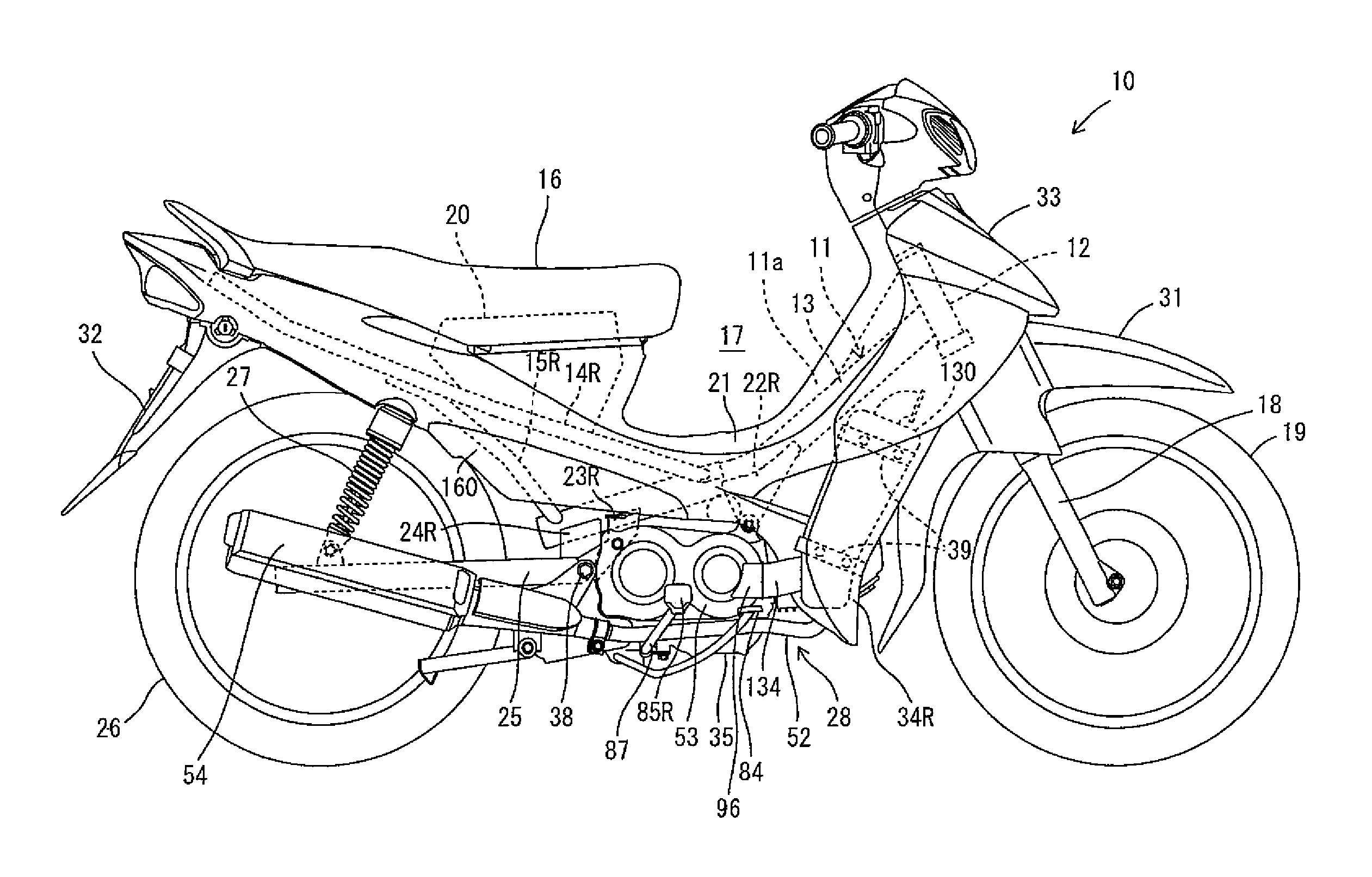Saddle-ride type vehicle
a saddle-ride type, vehicle technology, applied in cycle equipment, cycle, gear, etc., can solve the problem of reducing the cooling capacity of the v-belt continuously variable transmission, and achieve the effect of improving the cooling capacity and downsizing the body cover
- Summary
- Abstract
- Description
- Claims
- Application Information
AI Technical Summary
Benefits of technology
Problems solved by technology
Method used
Image
Examples
first embodiment
[0031]As shown in FIG. 1, a saddle-ride type vehicle according to a first embodiment of the invention is a motorcycle 10. The motorcycle 10 comprises a vehicle body frame 11, which makes a framework, and a seat 16, on which a passenger is seated. The motorcycle 10 is a so-called moped type motorcycle. That is, the motorcycle 10 includes a space 17 formed forwardly of the seat 16 to be recessed downward and shaped concave as viewed in side view, and a passenger seated on the seat 16 straddles the vehicle body frame 11 to ride. As used in the following description, “moped type” refers to a kind of vehicle in terms of shape, but provides no limitation in maximum speed, displacement, magnitude, etc. of a vehicle.
[0032]The saddle-ride type vehicle according to the invention is not limited to a moped type motorcycle but may be a motorcycle of other type such as, for example, a motorcycle type in which a fuel tank is arranged forwardly of a seat.
[0033]In the following description, front an...
second embodiment
[0116]As shown in FIG. 1, according to the first embodiment, the intake duct 134 extends forwardly of the transmission case 53 and the air chamber 130 extends from around a lower end of the leg shield 34R to around an intermediate portion thereof in the vertical direction. In contrast, as shown in FIG. 12, according to a second embodiment of the invention, an air chamber 141 is arranged above an intermediate portion of a leg shield 34R and a part of an intake duct 142 extends obliquely upward along the leg shield 34R.
[0117]According to the second embodiment, the intake duct 142 is connected to a first bulge portion 93 (see FIG. 7) of a transmission case 53 from obliquely upward. The intake duct 142 extends forwardly and obliquely upwardly of the transmission case 53 to be bent upward at the back of the leg shield 34R, and then extends obliquely upward along the leg shield 34R to be connected to the air chamber 141.
[0118]The air chamber 141 is arranged in a position above a lower end...
third embodiment
[0121]According to the first embodiment and the second embodiment, an intake passage, through which air is introduced into belt chamber 67, is provided between the transmission case 53 and the leg shield 34R. In contrast, according to a third embodiment of the invention, an exhaust passage, through which air discharged from a belt chamber 67 is led, is provided between a transmission case 53 and a leg shield 34R as shown in FIG. 13.
[0122]That is, according to the third embodiment, an exhaust duct 151 is connected to a connecting pipe 96 of the transmission case 53. The exhaust duct 151 is extended forwardly of the transmission case 53 and curved obliquely upward and rearwardly of the leg shield 34R. Further, the upwardly curved exhaust duct 151 is curved downward above an intermediate portion of the leg shield 34R in a vertical direction to extend to the vicinity of a lower end 34a of the leg shield 34R. A downstream end 151a of the exhaust duct 151 is opened downward. In addition, ...
PUM
 Login to View More
Login to View More Abstract
Description
Claims
Application Information
 Login to View More
Login to View More - R&D
- Intellectual Property
- Life Sciences
- Materials
- Tech Scout
- Unparalleled Data Quality
- Higher Quality Content
- 60% Fewer Hallucinations
Browse by: Latest US Patents, China's latest patents, Technical Efficacy Thesaurus, Application Domain, Technology Topic, Popular Technical Reports.
© 2025 PatSnap. All rights reserved.Legal|Privacy policy|Modern Slavery Act Transparency Statement|Sitemap|About US| Contact US: help@patsnap.com



